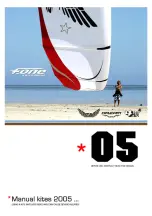
6.1.3
Aerotowing
6.1.4
Tow Line Break
6.2
Flying
6.2.1
General
In order to check trim speed and not to exceed the maximum certified speed of 62 mph, you should
fly with an airspeed indicator.
6.2.2
Flap Positions
Page
12
1.
Take off: Flap deflection approx. 15°. The flap bungee looks straight out of the keel
.
Caution: Stalling (falling below the minimum airspeed) can lead to a "lockout" or spin even
while on the rope
.
Caution: Always begin with the tow rope over the basetube. Do not engage the rope under
the basetube until at an altitude where a complete landing circuit can be flown
.
When aerotowing with no wind, start with a 10-15°. With wind, a flap position of 5° is better, as it
allows you to more eaily match the speed of the tug. The directional stability of the ATOS-VRS
LIGHT is also better at this flap setting
.
Important:
Do not get caught on tow lower than the tug! The ATOS pitches very strongly when
flying into the downwash and the propeller gusts of the tug. If the tow plane climbs steeply after
take-off, you must climb immediately to avoid being caught in the downwash of the tow plane
.
Caution
: If the tow rope is too short, the aerotow cart can suddenly turn to one side. This is due to
the approach vortex and the propeller wash of the tug reaching the glider before it reaches a
proper airspeed. If this happens release immediately
.
If the tow rope or weak link breaks, it is fine to land with the flaps in the take-off position, as long as
thereis sufficient landing field distance available. Be sure to maintain good airspeed and disconnect
any rope remaining with you before landing
.
The ATOS has a high level of overall stability. Control movements should be made smoothly. To
initiate a turn, move the control frame until the desire bank angle is achieved, then return to the
neutral position. Pulse-like movement adds no advantage in terms of maneuverability and results in
greater drag due to full deflections of the spoiler. When a spoiler deflects, there is a righting
moment, so you have to pay attention to airspeed, especially when changing direction. When
turning, you should pull in slightly so as not to accidentally fly too slowly.
The spoilers create a high yaw moment when deployed more than 50%. This is an advantage when
you want to change direction quickly, such as circling in a thermal. In high-speed flight, a full
deflection of the spoiler will result in large yawing. Be aware that when entering turbulence, a yaw
oscillation can be induced by alternating full spoiler deflections. The oscillation will immediately
cease if you center the contol bar. At speeds greater than 40 mph with flaps set at 70° and at
speeds greater than 47 mph with a flap setting of 0° to 15°, use smaller spoiler deflections.






































